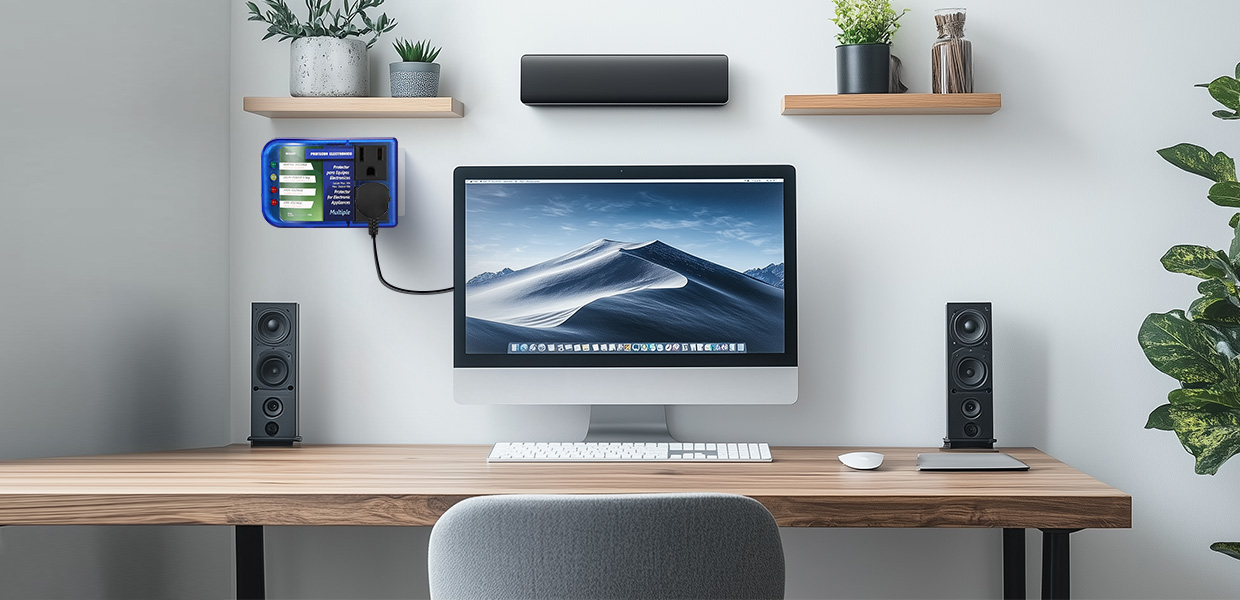As a device that is sensitive to voltage, a TV may be damaged when it encounters a power surge, which may even cause data loss or hardware damage. So some consumers have questions, what kind of surge protector do I need for my TV? Is it okay to plug the TV into a power surge protector? Here is the answer time.
What kind of surge protector do I need for my Television?
Television guard supplier tells you,When selecting a surge protector for your television, there are a few key factors to consider to ensure both safety and performance:
▶ Surge Protection Rating (Joules)
Joules measure how much energy a surge protector can absorb before it becomes ineffective. For a TV, you should look for a surge protector with a rating of 1000 joules or higher. The higher the joules rating, the better protection it offers.

▶ Clamping Voltage
The clamping voltage is the level at which the surge protector kicks in to divert excess voltage. A lower clamping voltage means faster response to surges, offering better protection. Look for a surge protector with a clamping voltage of around 400 volts or lower.
▶ Response Time
Surge protectors act quickly to divert electrical surges. A response time of less than 1 nanosecond is ideal for protecting sensitive electronics like your TV.
▶ Number of Outlets
Ensure the surge protector has enough outlets to plug in your TV and any other electronics you need (like a soundbar, DVD player, gaming console, etc.). At least 4-6 outlets should be sufficient for most setups.
▶ Warranty & Insurance
Many surge protectors come with a warranty that guarantees protection for your equipment in case of a surge. Some brands even offer insurance that will cover any damage to your electronics if the surge protector fails.
▶ Cord Length
Depending on where you place your TV and power sources, make sure the surge protector has a long enough power cord to reach the outlet.
▶ Compatibility with HDMI or AV Systems
If you have external devices (soundbars, gaming consoles, etc.) connected to your TV, make sure the surge protector supports coaxial or HDMI surge protection to prevent any surges from affecting those devices too.
Conclusion:
Choose a surge protector with a high joules rating (1000 joules or higher), a low clamping voltage, and enough outlets for your devices.

Is it good to plug a TV into a power surge protector?
Yes, it is a good idea to plug your TV into a power surge protector. Here’s why:
Protects Against Voltage Surges
Surge protectors are specifically designed to safeguard electronic devices from voltage spikes or surges, which can be caused by various factors like lightning strikes, power outages, or issues in the electrical grid. Without a surge protector, your TV is vulnerable to sudden spikes in electricity that could damage the internal components.
◆ Prevents Long-Term Damage
Even if a surge doesn’t completely destroy your TV, repeated exposure to small surges can lead to gradual wear and tear on the internal circuitry, potentially shortening the lifespan of the TV. A surge protector helps to filter out these harmful surges, protecting your investment over time.
◆ Adds Convenience and Protection for Other Devices
A surge protector usually comes with multiple outlets, meaning you can also plug in other devices, such as soundbars, gaming consoles, DVD players, or streaming boxes. This means you can protect all of your home entertainment electronics with a single surge protector.
◆ Reduces Electromagnetic Interference (EMI)
Some surge protectors offer features like EMI/RFI filtering (Electromagnetic Interference / Radio Frequency Interference), which can help reduce interference that might affect the picture and sound quality of your TV.
◆ Warranty & Insurance
Many surge protectors come with warranties or insurance that cover damage to devices plugged into them in the event of a power surge. This added peace of mind can be especially important for expensive electronics like flat-screen TVs.
◆ Things to Consider:
Don’t use an old or cheap surge protector: Over time, surge protectors lose their effectiveness, especially if they’ve absorbed multiple surges. Be sure the one you’re using is still rated to protect your devices.
Not all power strips are surge protectors: Make sure the power strip you’re using explicitly states that it offers surge protection. Simply using a basic power strip (without surge protection) will not help.
TV type: High-end TVs, especially OLED or 4K models, may have more sensitive electronics, so it’s even more crucial to provide them with proper surge protection.
Television guard Conclusion:
It’s definitely a good practice to plug your TV into a surge protector, as it helps shield your TV from power surges and electrical issues, extending its life and reducing the risk of damage. Make sure you choose a surge protector with a high joules rating, proper clamping voltage, and a warranty for the best protection.




